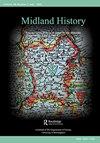‘Transforming Sorrow into a Thousand Flowers’: Refashioning a Midlands’ Celebration of Death from the 1890s
IF 0.1
Q3 HISTORY
引用次数: 0
Abstract
ABSTRACT A cultural revival in funeral floriography – the secret language of flowers – is a novel feature of modernity neglected by historiography. A ‘Russian flu’ pandemic which swept across Britain in the 1890s was a commercial catalyst for the floral industry. An excess in mortality of 125,000 people, reflected how 60% of the population were infected with influenza between 1889 and 1895. The floristry business flourished, by following the fashion to line graves with flowers and display them at crematoriums. In standard historical accounts, consumers were supposed to be less willing to buy into this elaborate funeral flora. Seldom have historical studies appreciated the popularity of floral tributes for the dead in provincial England. In a Midlands' case study , the experiences across provincial central England, touching on northern communities, highlight how florists were at the forefront of reviving floral death customs, some of which had not been in vogue since the eighteenth century.“化悲伤为千花”:重塑19世纪90年代中部地区的死亡庆典
葬礼花艺——花的秘密语言——的文化复兴是史学忽视的现代性的一个新颖特征。19世纪90年代席卷英国的“俄罗斯流感”是花卉业的商业催化剂。死亡率超过125000人,反映出1889年至1895年间60%的人口感染了流感。花店生意蓬勃发展,因为它紧跟潮流,在坟墓里摆满鲜花,并在火葬场展出。在标准的历史记录中,消费者应该不太愿意购买这种精心制作的葬礼植物群。很少有历史研究能欣赏到在英格兰省为死者献上鲜花的流行。在米德兰的一项案例研究中,英格兰中部各省的经历,涉及北部社区,突显了花店是如何站在复兴花卉死亡习俗的最前沿的,其中一些习俗自18世纪以来就不流行了。
本文章由计算机程序翻译,如有差异,请以英文原文为准。
求助全文
约1分钟内获得全文
求助全文

 求助内容:
求助内容: 应助结果提醒方式:
应助结果提醒方式:


